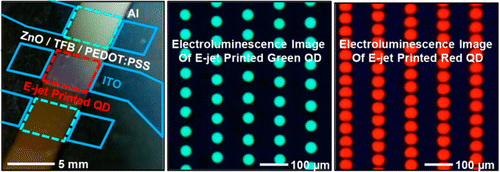January 28, 2015 weblog
High-resolution patterns of quantum dots with e-jet printing

A team of 17 materials science and engineering researchers from the University of Illinois at Urbana−Champaign and Erciyes University in Turkey have authored "High-Resolution Patterns of Quantum Dots are Formed by Electrohydrodynamic Jet Printing for Light-Emitting Diodes." Their paper was published in Nano Letters, an ACS journal. They demonstrated the materials and operating conditions that allow for high-resolution printing of layers of quantum dots with precise control over thickness and submicron lateral resolution and capabilities, for use as active layers of QD light-emitting diodes. They wrote, "Patterning QDs with precise control of their thicknesses and nanoscale lateral dimensions represent two critical capabilities for advanced applications. The thickness can be controlled through a combination of printing parameters including the size of the nozzle, the stage speed, ink composition, and voltage bias."
Their work on high-resolution patterns of quantum dots is of interest as it shows that advanced techniques in "e-jet printing" offer powerful capabilities in patterning quantum dot materials from solution inks, over large areas. (E-jet printing refers to a technique called electrohydrodynamic jet, described as a micro/nano-manufacturing process that uses an electric field to induce fluid jet printing through micro/nano-scale nozzles.)
Katherine Bourzac in Chemical & Engineering News wrote about this technique and the research interests of John Rogers, co-author of the paper and a materials scientist at the University of Illinois, Urbana-Champaign. The resolution of conventional ink-jet printers is limited. For the past seven years, she said, Rogers has been developing the electrohydrodynamic jet printing method. "This kind of printer works by pulling ink droplets out of the nozzle rather than pushing them, allowing for smaller droplets. An electric field at the nozzle opening causes ions to form on the meniscus of the ink droplet. The electric field pulls the ions forward, deforming the droplet into a conical shape. Then a tiny droplet shears off and lands on the printing surface. A computer program controls the printer by directing the movement of the substrate and varying the voltage at the nozzle to print a given pattern."
Dot, line, square, and complex images as QD patterns are possible, the researchers said, with tunable dimensions and thickness. They wrote that "these arrays as well as those constructed with multiple different QD materials, directly patterned/stacked by e-jet printing, can be utilized as photoluminescent and electroluminescent layers."
What does their work mean for consumers? As for TV technology, nearly every TV manufacturer at CES this year, remarked Geoffrey Morrison in CNET, said quantum dots helped deliver better, more lifelike color. Writing in IEEE Spectrum on Monday, Prachi Patel similarly made note that "Quantum dots (QDs) are light-emitting semiconductor nanocrystals that, used in light-emitting diodes (LEDs), hold the promise of brighter, faster displays."
In the IEEE story headlined "High-Resolution Printing of Quantum Dots For Vibrant, Inexpensive Displays," Patel said these researchers repurposed a printing method which they devised for other applications. Patel wrote: "When used with 'QD ink,' it can create lines and spots that are just 0.25 micrometers wide. They made arrays and complex patterns of QDs in multiple colors, and could even print QDs on top of others of a different color. They sandwiched these patterns between electrodes to make bright QD LEDs." Patel also reported on the team's future efforts. They are working on arrays of multiple nozzles. Inkjet printers usually have a few hundred nozzles, said Patel. "The difficulty with the e-jet printing method is that the electric field at one nozzle affects the fields of neighboring nozzles." They are trying to figure out "how to isolate nozzles in order to eliminate that crosstalk."
More information: High-Resolution Patterns of Quantum Dots Formed by Electrohydrodynamic Jet Printing for Light-Emitting Diodes, Nano Lett., Article ASAP. DOI: 10.1021/nl503779e
Abstract
Here we demonstrate materials and operating conditions that allow for high-resolution printing of layers of quantum dots (QDs) with precise control over thickness and submicron lateral resolution and capabilities for use as active layers of QD light-emitting diodes (LEDs). The shapes and thicknesses of the QD patterns exhibit systematic dependence on the dimensions of the printing nozzle and the ink composition in ways that allow nearly arbitrary, systematic control when exploited in a fully automated printing tool. Homogeneous arrays of patterns of QDs serve as the basis for corresponding arrays of QD LEDs that exhibit excellent performance. Sequential printing of different types of QDs in a multilayer stack or in an interdigitated geometry provides strategies for continuous tuning of the effective, overall emission wavelengths of the resulting QD LEDs. This strategy is useful to efficient, additive use of QDs for wide ranging types of electronic and optoelectronic devices.
Journal information: Nano Letters
© 2015 Phys.org



















